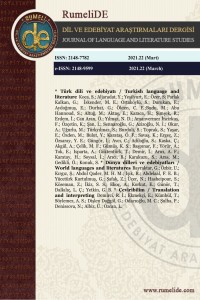Abstract
Murat Gülsoy’un İstanbul’da Bir Merhamet Haftası (2007) romanında projeci yazar, hayatlarında bir şekilde bulunduğu yedi kişiye, Max Ernst’e ait yedi farklı resmi, pazar gününden başlayarak gönderir. Projeci yazar; Ali, Yağmur, Halil, Deniz, Ayşe, Akın ve Erol adlı kişilerden resimlere bakıp içlerinden geleni “otomatik yazı” biçiminde yazmalarını ister. Metinlerin yazımında üslup ve tür konusunda herhangi bir sınırlama yapmaz. Projede görev alan kişiler ile proje boyunca resimleri ulaştırmak dışında herhangi bir şekilde iletişim kurmaz. Projeci yazar, farklı kişilerin oluşturacağı bu metinleri kitaplaştırmayı ve kitaba katkısı bulunan yedi kişiye birer adet vermeyi amaçlar. Çalışmamızda, İstanbul’da Bir Merhamet Haftası adlı romanın dilsel, türsel ve söylemsel analizi yapılarak “diyaloji”, “polifoni” ve “heteroglossia” gibi kavramlar ışığında romandaki diyalojik ağın analizinin yapılması hedeflenir. Mihail Mihailoviç Bahtin’in (1895- 1975) edebiyat eleştirisine kazandırdığı diyaloji kuramından hareketle İstanbul’da Bir Merhamet Haftası adlı romandaki diyalojik ilişkiler açığa çıkarılmıştır. Romanda yer alan söylem tiplerinin çözümlemesi yapılarak romanın diyalojik özelliklere haiz olduğu ortaya konulmuştur. Gizli diyalog, göz ucuyla bakış, iç konuşma, itiraf gibi tekniklerle romanın içeriğinde diyalojik dinamiğin sağlandığı tespit edilmiştir. Karakterlerin kendi seslerini temsil ettiği belirlenerek söz konusu eserin polifonik roman kategorisinde yer alabileceği kaydedilmiştir. Romandaki olay örgüsünün, görsel sanatlardan resim ve edebî türlerden mektup, şiir, makale vasıtasıyla ilerlediği saptanarak romanın farklı sesleri bünyesinde taşıyan heteroglot bir yapıya sahip olduğu görülmüştür.
Keywords
References
- Aktulum, K. (2000). Metinlerarası İlişkiler. Ankara: Öteki...................................
- Bahtin, M. M. (2001). Karnavaldan Romana. (Çev. C. Soydemir). İstanbul: Ayrıntı.
- Bahtin, M. M. (2004). Dostoyevski Poetikasının Sorunları. (Çev. C. Soydemir). İstanbul: Metis.
- Bahtin, M. M. (2005). Sanat ve Sorumluluk. (Çev. C. Soydemir). İstanbul: Ayrıntı.
- Bahtin, M. M. (2016). Söylem Türleri ve Başka Yazılar. İstanbul: Metis.
- Brandist, C. (2011). Bahtin ve Çevresi Felsefe, Kültür ve Politika. (Çev. C. Soydemir). Ankara: Doğubatı.
- Çakır, Ö. (2005). Türk Edebiyatında Mektup. Basılmamış doktora tezi. Gazi Üniversitesi, Sosyal Bilimler Enstitüsü, Ankara.
- Çakmakçı, M. (2009). Mikhail Bakhtin: Edebiyatın Gerçeklendirilmesi. Uluslararası Sosyal Araştırmalar Dergisi/ The Journal of İnternational Social Resarch, 2/6, 98-109. Ergeç, Z. (2018). Bahtin'in Diyaloji Kuramı Çerçevesinde Modern Türk Romanına Bir Yaklaşım. Basılmamış doktora tezi. Çukurova Üniversitesi, Sosyal Bilimler Enstitüsü, Adana.
- Gülsoy, M. (2018). İstanbul'da Bir Merhamet Haftası. İstanbul: Can Sanat.
- Günay, D. (2013). Söylem Çözümlemesi. İstanbul: Papatya.
- Hitchcock, L. A. (2015). Kuramlar ve Kuramcılar. (Çev. S. Pekşen). İstanbul: İletişim.
- Madran, C. Y. (2012). Modern İngiliz Romanında Mikhail Bakhtin. İstanbul: Gündoğan.
Abstract
In Murat Gülsoy’s novel, A Mercy Week in Istanbul (2007), the project writer sends seven different pictures of Max Ernst to seven people who have taken place in his life in some way, starting from a Sunday. The project writer asks Ali, Yağmur, Halil, Deniz, Ayşe, Akın, and Erol to look at the pictures and write whatever comes to mind in the form of “automatic writing.” He doesn’t make any restrictions for the style and genre in the writing of the texts. He does not communicate with the people involved in the project in any way other than delivering the pictures throughout the project. The project writer aims to make these texts, which will be written by different people, into a book and publish it and to give one to each of the seven people who have contributed to the book. In our study, by analyzing the novel A Mercy Week in Istanbul in terms of a language, genre, and discourse, it is aimed to analyze the dialogic network within the novel in the light of concepts such as “dialogism,” “polyphony,” and “heteroglossia.” Based on the concept of dialogism that Mihail Mihailoviç Bahtin (1895-1975) introduced to literary criticism, the dialogic relations in the novel A Mercy Week in Istanbul are examined. By analyzing the types of discourse in the novel, it is revealed that the novel has dialogic features. It was found that dialogical dynamics are established in the novel with techniques such as secret dialogue, glancing with the corner of the eye, inner speech, and confession. It is noted that the characters represent their own voice and that the work can be included in the category of polyphonic novel. It is seen that the plot in the novel progresses through pictures from visual arts and letters, poems, and articles from literary genres, and has a heteroglot structure that involves different voices.
Keywords
References
- Aktulum, K. (2000). Metinlerarası İlişkiler. Ankara: Öteki...................................
- Bahtin, M. M. (2001). Karnavaldan Romana. (Çev. C. Soydemir). İstanbul: Ayrıntı.
- Bahtin, M. M. (2004). Dostoyevski Poetikasının Sorunları. (Çev. C. Soydemir). İstanbul: Metis.
- Bahtin, M. M. (2005). Sanat ve Sorumluluk. (Çev. C. Soydemir). İstanbul: Ayrıntı.
- Bahtin, M. M. (2016). Söylem Türleri ve Başka Yazılar. İstanbul: Metis.
- Brandist, C. (2011). Bahtin ve Çevresi Felsefe, Kültür ve Politika. (Çev. C. Soydemir). Ankara: Doğubatı.
- Çakır, Ö. (2005). Türk Edebiyatında Mektup. Basılmamış doktora tezi. Gazi Üniversitesi, Sosyal Bilimler Enstitüsü, Ankara.
- Çakmakçı, M. (2009). Mikhail Bakhtin: Edebiyatın Gerçeklendirilmesi. Uluslararası Sosyal Araştırmalar Dergisi/ The Journal of İnternational Social Resarch, 2/6, 98-109. Ergeç, Z. (2018). Bahtin'in Diyaloji Kuramı Çerçevesinde Modern Türk Romanına Bir Yaklaşım. Basılmamış doktora tezi. Çukurova Üniversitesi, Sosyal Bilimler Enstitüsü, Adana.
- Gülsoy, M. (2018). İstanbul'da Bir Merhamet Haftası. İstanbul: Can Sanat.
- Günay, D. (2013). Söylem Çözümlemesi. İstanbul: Papatya.
- Hitchcock, L. A. (2015). Kuramlar ve Kuramcılar. (Çev. S. Pekşen). İstanbul: İletişim.
- Madran, C. Y. (2012). Modern İngiliz Romanında Mikhail Bakhtin. İstanbul: Gündoğan.
Details
| Primary Language | Turkish |
|---|---|
| Subjects | Linguistics |
| Journal Section | Turkish language, culture and literature |
| Authors | |
| Publication Date | March 21, 2021 |
| Published in Issue | Year 2021 Issue: 22 |


